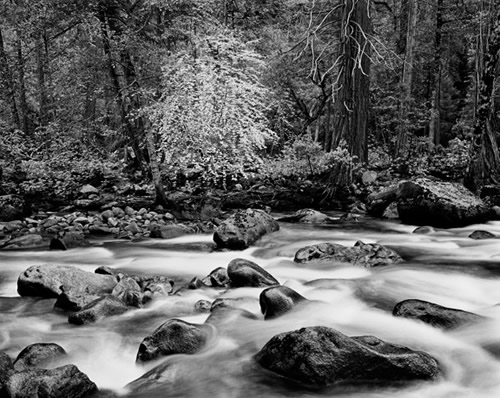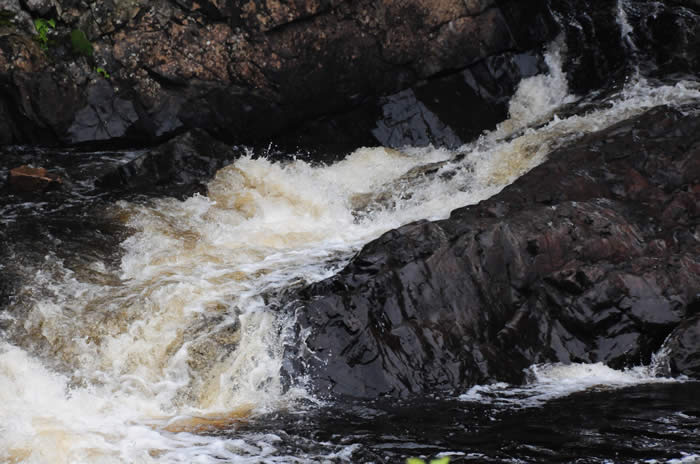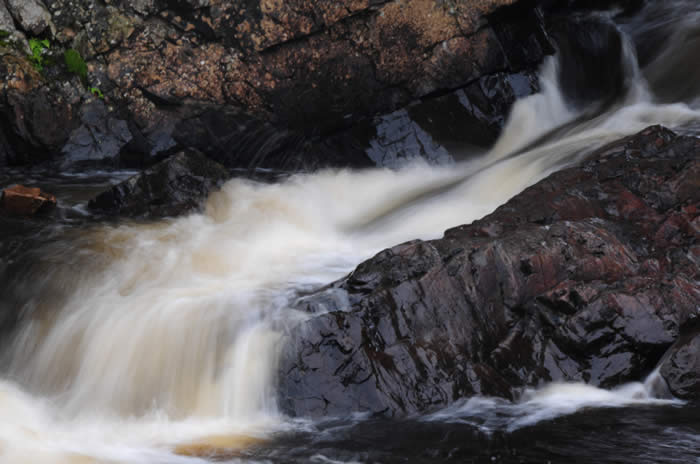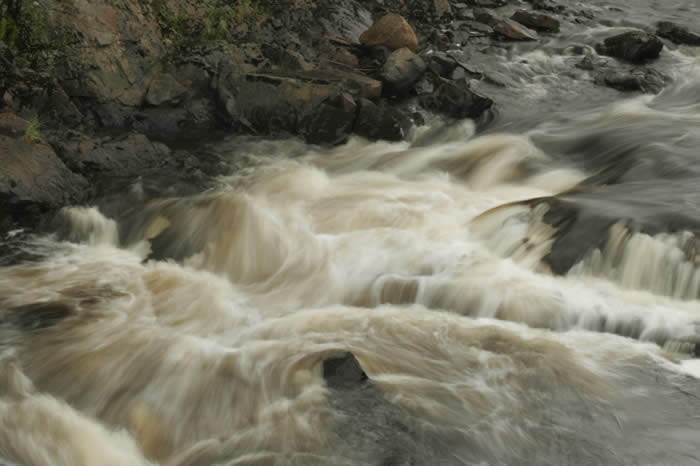Go Back to current column
Flowing Water, Frozen Water
--different ways to shoot it, even in bright sun
By Frank Van Riper
Photography Columnist
Landscape photographers like Ansel Adams, Paul Caponigro, John Sexton and many more have at one time or another made photographs of water rushing sensuously, sinuously downstream against a backdrop of jagged rocks rendered tack sharp.
The contrast is irresistible: the sharply rendered surfaces of the rocks against the “softness” of water that emerges smooth, even glass-like, during seconds-long exposures while the camera is firmly anchored to a tripod.
In many previous cases, especially in large format, photographs like these were made on film, and the necessarily long exposures required to record water in motion also required that the scene be photographed in somewhat subdued light—certainly not in bright sun.
 |
"Merced River and Forest" by John Sexton. Made in1983, this glorious photo was created in "the dark but luminous light of dusk." But similar results can be made in bright sun as well. For more information on this great photographer and teacher, go to www.johnsexton.com
(c) John Sexton. All Rights Reserved |
I recall many years ago, while studying at the Maine Photographic Workshops, I took this technique to extreme and made an all-night-long exposure from the lakeside cabin we had rented, tripping the shutter right before Judy and I went to bed and closing it only after we got up the next morning. The result was an eerily beautiful image of the lake surrounded by evergreen trees silhouetted in the moonlight—the lake itself having been turned into a smooth shiny mirror. [The continuous rippling of the water overnight evened everything out to make it appear as if there were only one smooth surface, kissed all night by moonlight.]
In order to achieve this effect, I relied on several things: a firm tripod to keep my camera steady all night, a very small aperture (f.22) to take in the light in small sips, not big gulps, over the course of a seven or eight-hour exposure—and a very slow color transparency film like Fujichrome Velvia, ISO 50.
Obviously, the darkness of night was vital for this photograph to work. Anything approaching such a long exposure in daylight, even at f. 22, would result in a highly over-exposed, totally blown-out image.
But long-exposure images of rushing water can be made in daylight—even in bright sun—and fairly easily, too. All you have to do is transfer some of the techniques I used during my all-nighter with a film camera to your present-day digital one.
My wife Judy and I demonstrate this technique every summer during our photography workshops in Lubec, Maine (www.summerkeys.com -- click Lubec Photo Workshops.) First I make an exposure of rushing water at a shutter speed so high that I can catch droplets in mid-air. Then, barely seconds later and never moving my camera or using any filters, I make the same shot under the same bright lighting conditions at a shutter speed of at least one second, if not longer. The resulting image is just as perfectly exposed as the first one, only this time the water is a sinuous ribbon.
 |
 |
| Bad Little Falls in Machias, Maine offers spectacular, easily photographable, views within walking distance of a gas station. These two images were made in bright sun, within seconds of each other. (c) Frank Van Riper |
There is absolutely no post-production tweaking involved; no doctoring. Both images—frozen water and flowing water--are absolutely unmanipulated.
I admit: the first time I tried this, it felt like a conjuring trick.
This part of the world really is our little piece of heaven, and we can’t wait to spend every summer there. In addition to gorgeous vistas, colorful lobster boats, quiet harbors, working waterfronts—not to mention summer nights in which we sleep under a quilt to the wonderment of our friends in steaming Washington, DC--this part of Down East Maine also features a uniquely beautiful display of white water in the heart of the tiny town of Machias, barely a hundred yards from a gas station!
Bad Little Falls, as it is known, is a confluence of rocks and water that calls to mind the beautiful violence of rushing water in places like Colorado or Oregon. Only you do not have to hike miles to get to it.
When Judy and I first saw the falls many years ago it was a revelation—and also a reminder of Down East Maine’s rich history. For years, the surging power of the water helped generate electricity, while other parts of the Machias River saw great flotillas of logs make their way downriver to sawmills, guided by lumberjacks of amazing agility and skill who walked, miraculously so it seemed, on the tight surface of the logs, breaking up jams with their long Peaveys.
 |
| Another view of the falls, by one of our students, who never had done this before. Great job, Gabe. (c) Gabriel Winski |
So photographing Bad Little Falls became merely an extension of my long effort to document life in this magical place, an effort that produced my book, Down East Maine/A World Apart, in 1998.
The first-time viewer of Bad Little Falls would be amazed by the beauty of the surging water and, if he or she were a photographer, also would be delighted by the aerial vantage points provided by the town—a small above-the-water park area, complete with gazebo, as well as a footbridge—all seemingly designed for people wanting to make photos.
Someone encountering the falls on a sunny day from either of these points probably would get a decent exposure of the water even with his or her camera set to Program, a setting I rarely if ever use. Since Program mode reflects the understandable, generally held, belief that high shutter speeds at comparatively high ISO’s will diminish exponentially the chance of image-degrading camera shake, the image made by the snapshooter likely would be tack sharp—perhaps even freezing drops of water in mid-air.
That’s fine as far as it goes, but if the shooter wanted to be more creative and show the water flowing, changing the shooting mode to manual and slowing the shutter speed and stopping down the lens opening, the resultant photo probably would still freeze the stream of water. For example, a shot of the water made wide open at 1/2000th of a second likely would look an awful lot like the same image made stopped down to the max and shot at 1/250th.
But here’s where digital’s ability to, in effect, “change film” in an instant can be a great creative tool.
In the old film days, someone in this situation (bright sun, remember) who wanted to shoot both “frozen” water and falling water during the same shoot either would have to literally change to a slower film to allow for really long shutter speeds, or use a neutral density filter over the lens to fool the camera into thinking the film was suddenly not so light sensitive, or “fast.” (Any landscape shooter worth his or her salt would not think of leaving the house without at least one ND filter.) These filters come is varying degrees of darkness, as well as in graduated form. These “grad filters” often are used for horizontal landscape shots featuring great expanses of sky. A grad filter positioned over the lens with the dark portion over the sky will allow the photographer to use slower shutter speeds to better render foreground detail and not blow out the sky in the process.
Certainly, judicious use of ND filters would have helped in the case of Bad Little Falls, but my solution was a heck of a lot simpler—even elegant.
I simply changed my camera’s ISO to the lowest it could go, metered accordingly while seeking the longest possible shutter speed, and happily shot my images with the camera mounted on a tripod. The “exposure value” of my high-ISO, high shutter speed images were identical to those shot at low-ISO, slow shutter speed so both sets of photos looked the same, except for the rendering of the water.
It was that simple.
Changing the ISO is no big secret. But if you are like me, you probably think most about doing this not when you are in bright sun but when you are shooting in low light. Then you naturally want to crank up your ISO as high as possible, especially if you are shooting without flash. (The amazing ability of modern digital camera sensors to render low-light images without nearly as much digital noise as in the past makes this technique a no-brainer in most cases.)
Here, however, at Bad Little Falls under a bright summer sun in down east Maine, the concept of less being more—at least in terms of one’s operating ISO—shone.
Frank Van Riper is a Washington-based photographer, journalist, author and lecturer. He served for 20 years in the New York Daily News Washington Bureau as White House correspondent, national political correspondent and Washington bureau news editor, and was a 1979 Nieman Fellow at Harvard. His photography books include Faces of the Eastern Shore and Down East Maine/ A World Apart, and Talking Photography, a collection of his Washington Post and other photography writing over ten years. His latest book (done in collaboration with his wife and partner Judith Goodman) is Serenissima: Venice in Winter www.veniceinwinter.com
Van Riper’s photography is in the permanent collections of the National Portrait Gallery and the National Museum of American Art in Washington, and the Portland Museum of Art, Portland, Maine. He can be reached through his website www.GVRphoto.com
[Copyright Frank Van Riper. All Rights Reserved. Published 8/10]
|